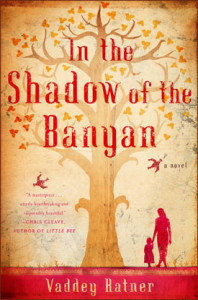Not the Same Old Story
February 11, 2013The Medium is the Message
March 5, 2013Book Review: In the Shadow of the Banyan
 The best literature is capable of taking ugliness and spinning it into something beautiful. By that I don’t mean that it sugarcoats the bad or conceals that which should see the light of day—though writing can do that as well—but rather that it can start from a place of great darkness and transform it into a truer, more enduring reality without losing the essential nature of the thing, like a lump of coal compressed into a diamond. (N.B., despite the proverbs, diamonds aren’t actually formed from coal, so there’s another example of the transformative power of an idea once we’ve collectively agreed to subscribe to it.)
The best literature is capable of taking ugliness and spinning it into something beautiful. By that I don’t mean that it sugarcoats the bad or conceals that which should see the light of day—though writing can do that as well—but rather that it can start from a place of great darkness and transform it into a truer, more enduring reality without losing the essential nature of the thing, like a lump of coal compressed into a diamond. (N.B., despite the proverbs, diamonds aren’t actually formed from coal, so there’s another example of the transformative power of an idea once we’ve collectively agreed to subscribe to it.)
This notion accompanied me throughout the reading of Vaddey Ratner’s In the Shadow of the Banyan, a fictionalized account of her childhood years in Cambodia’s killing fields, where somewhere between one and two million people were murdered or died of starvation and disease (about a third of the country’s population at the time).
Like the members of Ratner’s family, the main characters in the novel are kicked out of their home in Phnom Penh and carted into the countryside along with thousands of their neighbors, where they are subjected to years of intimidation, forced labor, the splitting up of families, hunger, illness, suicide, and death. The lead character of Raami is seven at the start (in her own life, Ratner was five when the horrors began), and she witnesses a brutality that would be difficult even for an adult to grasp, yet she is also a soul in love with language, the poetry of her father, from whom she is separated early in the story.
To Raami, Papa’s stories are like a cooling mist that hangs over the rice fields in the monsoon heat. His voice, his words, his poet’s heart—these are the wellspring for the solace that sees her through the misery. “A story, I had learned, through my own constant knitting and re-knitting of remembered words, can lead us back to ourselves, to our lost innocence…It reflects itself in joy and grief, in my father’s sudden knowledge that he would not live to protect me, and in his determination to leave behind a part of himself—his spirit, his humanity—to illuminate my path, give light to my darkened world. He carved his silhouette in the memory of the sky for me to return to again and again.”
Though her writing is beautiful (and even more remarkable when you consider that English is not her native language), Ratner doesn’t wield its melodiousness like a siren, attempting to lull us into a trance. She never flinches from the meanness and venality that surrounds Raami, but instead filters it through her character’s gentle spirit. The effect is even more unnerving than if Ratner had hit us directly over the head with it; we ache to shield this child from everything she must endure. But the beauty of Raami’s vision is also life affirming, a beacon that persists undimmed in the face of absurdity and wickedness. Raami reminds us of a purity and a love that cannot be tarnished by evil.
In the Shadow of the Banyan by Vaddey Ratner (Simon & Schuster, August 2012).
